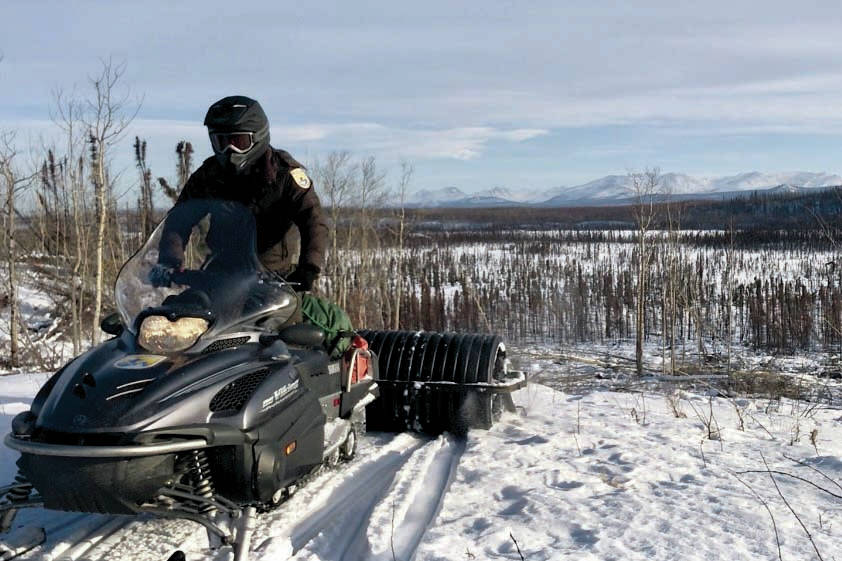The cross-country ski trails adjacent to the Kenai National Wildlife Refuge Headquarters and Visitor Center at the top of Ski Hill Road in Soldotna are a well-known and beloved community asset for many local skiers and snowshoers.
Regular visitors know the 2-mile loop maintained on Headquarters Lake is the “hot spot” for a quick lunch break ski on a sunny winter day. They are also familiar with the quiet and scenic escape they’re awarded for kicking and gliding their way out to Nordic Lake.
Snowshoeing the Keen Eye or Centennial trails is a daily ritual for some folks. Even with the variety of trail lengths, diversity of terrain and various challenge levels offered on these trails, sometimes we are all looking for that next great place for winter fun.
Marsh Lake Trail may just become that place.
Most recreational trails are a product of careful planning and thoughtful design. Pedology, hydrology and topography are studied and examined to make key decisions affecting construction standards and alignment. Marsh Lake Trail’s origin story, however, is less “ology” and more serendipity.
Marsh Lake Trail came into existence when the 8,876-acre Card Street Fire of 2015 burned onto two separate fuels treatment projects within the Skilak Wildlife Recreation Area. These areas, a 672-acre unit completed in 1984 and a 124-acre unit completed in 2009, had been mechanically treated for habitat improvement and educational purposes.
The combination of these treatments became an effective fuel break that slowed the progress and intensity of the fire to a level where firefighters could engage more directly. This afforded an essential tactical opportunity to further control the northern flank of the fire by establishing a 15- to 20-foot wide and 3.3-mile long dozer line cleared of all vegetation down to mineral soil.
Firefighters and equipment operators followed the irregular and unpredictable active burning edge of the fire from Mile 16.5 of Skilak Lake Road to Marsh Lake.
A total of 6.72 miles of dozer line were constructed during the Card Street Fire. At the conclusion of any wildfire incident, it is standard practice to repair any and all areas damaged or disturbed during suppression operations.
Reducing erosion and sedimentation, protecting sensitive wetland and riparian areas from further disturbance, and reducing opportunities for invasive plant establishment are key aspects of suppression repair, especially on a wildlife refuge.
Kenai refuge staff working on the incident realized a proposed trail to Marsh Lake was addressed in the 2007 Skilak Wildlife Recreation Area Revised Final Management Plan but had not come to fruition due to funding limitations. Recommendations were made to eliminate the dozer line to Marsh Lake from the suppression repair plan and retain the route for a new trail.
This vulnerable and open wound on the refuge represents the “lemon” staff were given, but the promise of a new trail with minimum effort and expense became the sweet lemonade.
Since the ceremonial ribbon cutting on Oct. 6, 2018, Marsh Lake Trail has become a popular summer hiking destination due to the diversity of forest habitat, exceptional scenic vistas and abundant wildlife viewing opportunities. The two new vault toilets at the trailhead might be playing some role as well.
The width of the trail and rolling terrain is well suited for skiing and snowshoeing, but up to this point the refuge has done little to advertise or encourage winter recreational use. Experimental attempts to groom the trail this winter were quickly discovered by local skiers and comments from users were very favorable. It is the intent of the refuge to continue to improve winter access to Marsh Lake through periodic compacting and grooming of the trail.
The trail conditions the refuge seeks to provide and the experience being managed for differs from that of the Tsalteshi Trails and the Refuge Headquarters ski trails.
Tracks will not be set and the compacted trail may be too narrow for skate skiing. Plan and be prepared for a backcountry skiing experience and then be surprised by above average conditions.
I would recommend metal edged skis or a good pair of Nordic touring or backcountry skis. The goal is to create a softer entry and a less intimidating experience for beginners looking to “up their game” or folks wanting to explore some new real estate.
Although I wouldn’t recommend Marsh Lake Trail to a first-timer, there is a 1-mile loop option that is suitable for beginner skiers and snowshoers. For the slightly more experienced, the 6-mile round trip to Marsh Lake can be traversed in three to five hours and does include a couple challenging hills.
The easiest way to access Marsh Lake Trail is from the west entrance to Skilak Lake Road at Mile 75 of the Sterling Highway. The trailhead is located at Mile 16.5 of Skilak Lake Road.
One of the best parts of my job is being part of a team that strives to offer the community new opportunities to enjoy, explore and appreciate our backyard that is the Kenai National Wildlife Refuge. The next time you find yourself on Marsh Lake Trail and wonder why the trail twists and turns, zigs and zags, rises and falls … that’s the sweet lemonade!
Scott Slavik is a Visitor Services Specialist, Wildland Firefighter and ski trail groomer for the Kenai National Wildlife Refuge. Find more Refuge Notebook articles (1999–present) at https://www.fws.gov/refuge/Kenai/community/refuge_notebook.html.
By SCOTT SLAVIK
Kenai National Wildlife Refuge


